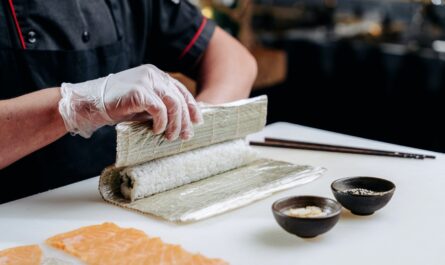Creating the ideal sushi experience begins with perfect rice, which is why understanding the art of maintaining sushi rice stickiness is so crucial. For sushi enthusiasts, the sticky rice serves as the foundation that holds each delicacy in place, making the overall dining experience unforgettable. But what makes sushi rice sticky, and how can we ensure it stays that way?

Understanding the Importance of Stickiness
The right level of stickiness in sushi rice ensures that the sushi remains intact, whether it’s in a roll or a piece of nigiri. This stickiness comes from the unique composition of the rice used, primarily short-grain which has a higher starch content. This characteristic allows the grains to adhere well, playing a key role in the structure and bite of the sushi.
Choosing the Right Type of Rice
When it comes to sushi, using the appropriate type of rice is paramount. Short-grain rice is the go-to choice due to its inherent stickiness. While there are many types of rice, sources like the Rice Association provide detailed insights into the varieties of rice, emphasizing short-grain rice as perfect for achieving the desired sticky consistency.
Preparation and Washing Techniques
The journey to sticky sushi rice starts with proper rinsing and preparation. Washing removes excess starch, which if left, can lead to gooey rather than sticky rice. Utilizing techniques available on soaking tips ensures your rice is prepped to perfection before cooking.
Cooking the Rice Perfectly
Cooking sushi rice correctly involves more than just following the instructions on a rice cooker. It’s about achieving the perfect balance of water to rice. Wrong measurements can lead to overly dry or mushy rice, both of which detract from the final dish. Explore the best equipment for this process on available pots for rice.
Seasoning the Rice
Once the rice is cooked, it must be seasoned with a mixture of rice vinegar, sugar, and salt to enhance its natural flavors and stickiness. This critical step not only accentuates the taste but also contributes to the right texture.
Using Bamboo Mats for Rolling
Rolling sushi correctly relies heavily on technique as well as the tools used. Bamboo mats are traditional tools that help in keeping the roll tight while the sticky rice stays intact. Discover how to maintain them odor-free at cleaning sushi tools.
Common Mistakes and How to Avoid Them
Being aware of common pitfalls in sushi preparation can save both time and effort. Not washing the rice enough, not using the right type of rice, or improper rolling techniques can all lead to less-than-perfect sushi.
Enhancing Your Sushi Experience
Once you’ve mastered the art of sticky rice, setting up and presenting your sushi is the final step to a culinary masterpiece. Learn more about setting up sushi for beautiful presentations.
Exploring New Horizons with Sushi Rice
As you gain confidence in your sushi-making skills, you might explore variations like sushi bowls and sushi wraps that challenge your creativity and skills in maintaining rice stickiness even in non-traditional forms.

FAQs
Why is short-grain rice ideal for sushi?
Short-grain rice has the right balance of amylose and amylopectin, making it sticky enough to hold sushi together.
Can I use medium or long-grain rice for sushi?
While possible, it’s not recommended, as these types typically do not achieve the necessary stickiness.
How can I keep my sushi looking fresh for pictures?
Keeping sushi at the right temperature and experimenting with lighting and angles helps maintain a fresh look for photos.
This article contains affiliate links. We may earn a commission at no extra cost to you.




